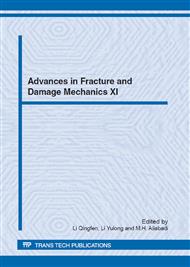p.233
p.237
p.241
p.245
p.249
p.253
p.257
p.261
p.265
Experimental Research on Interlaminal Shear Strength of GFRP Bridge Decks under Simulated Concrete Environment
Abstract:
Fiber reinforced plastic (FRP) composite which has high strength, high fatigue resistance, low density, and better corrosion resistances is desirable characteristics for bridge applications, especially decks. According to the ACI 440.3R04, Glass fiber reinforced plastic (GFRP) bridge deck samples were immersed into the simulated concrete environment at 60 for 92d (corresponds to the natural environment 25 years). The results show that, with the time increased, the interlaminal shear strength of GFRP bridge decks decreased significantly. After being exposed to the simulated concrete environment for 3.65d, 18d, 36.5d and 92d, the interlaminal shear strength degradation of GFRP bridge decks were 18.69%, 25.90%, 50.93% and 53.74%, respectively. The micro-formation of the GFRP bridge deck sample surface was surveyed under scanning electron microscopy (SEM), which indicated that with the aging time increased, corrosion pits in the surface of GFRP bridge decks became more obviously and the interface between fiber and resin was severely damaged. Therefore, the degradation of FRP under the simulated concrete environment should be considered in the design of FRP bridge decks.
Info:
Periodical:
Pages:
249-252
Citation:
Online since:
November 2012
Authors:
Price:
Сopyright:
© 2013 Trans Tech Publications Ltd. All Rights Reserved
Share:
Citation:


